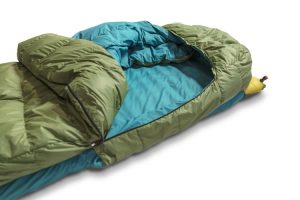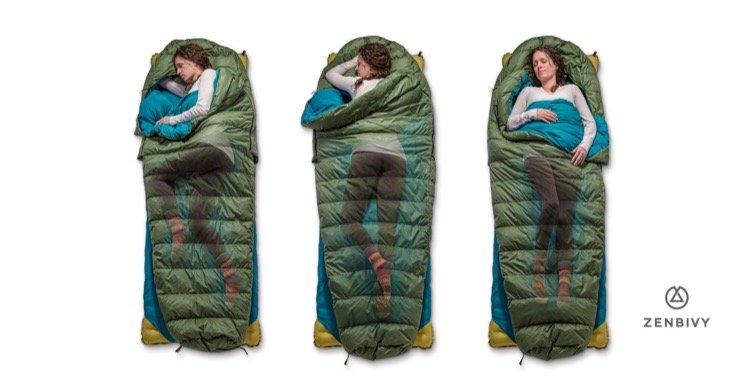 Our reviews are 100% organic. We do not accept payment for reviews or bundle with advertising budgets. In most cases, the brand is providing the product to our reviewers free of charge.
Our reviews are 100% organic. We do not accept payment for reviews or bundle with advertising budgets. In most cases, the brand is providing the product to our reviewers free of charge. Basic summary: Two non-traditional sleeping bag options for your next camping excursion.
Features:
| Frontcountry Bed 600 Hybrid (Size L) | Zenbivy Bed 25L | |
| Dimensions | 86” x 74” | 86” x 58” |
| Shell material | 50D Polyester taffetta | 20D polyester taffeta with Durable Water Repellent (DWR) |
| Liner material | 50D Polyester taffetta | 50D Polyester Pongee |
| Insulation | 600FP Dridown on top, short staple synthetic on bottom and sides | 700FP HyperDry water resistant down |
| EN comfort | 38 degrees | 34 degrees |
| EN limit | 28 degrees | 23 degrees |
| Shoulder girth | 74” | 76” |
| Foot girth | 74” | 44” |
| Weight | 4 lbs, 9 oz | 2 lbs, 12 oz |
| Fits mattress | 30” x 80”, up to 3” thick | 25” x 77”, up to 3” thick |
| MSRP | $210 | $280 |
Deep dive:
One of the most longstanding traditions of the ultrarunning community is car camping. Whether you’re road tripping to your favorite race, or dirtbagging at the start line to save time and money, sleeping in your car is something of a rite of passage for ultrarunners.
This summer and fall we tested two sleep systems on a number of outings: sometimes on the ground inside a tent, but other times spread out in the back seats of a compact SUV. Both of them are noteworthy in that they allow you to sleep in any position you prefer, and they both have clever design elements that give them improved functionality and versatility.

Frontcountry Bed
Sierra Designs Frontcountry Bed
Sierra Designs disrupted the sleeping bag category several years ago with the Backcountry Bed, a zipperless sleeping bag that featured an attached internal comforter that could either be tucked in or removed to regulate heat. More recently, the Frontcountry Bed takes that same design concept, but uses a rectangular shape that allows freedom of movement in the lower extremities in comparison to the tapered mummy-style shape of the Backcountry Bed. The larger footprint results in a significantly heavier bag than the Backcountry, but since you’re carrying it in your trunk instead of your backpack, weight isn’t a key issue – and the increase in comfort is a definite upgrade. (Across the model styles, the Frontcountry Beds tend to run about 10% cheaper than the Backcountry Beds also.)

Frontcountry Bed open
With zipperless construction, the Frontcountry Bed does not come apart on the sides; instead, you slide into the bag through the large oval opening on top that extends down to mid-thigh level. Although it’s great to not worry about zippers getting stuck or drafts coming through the seams, the principal downside of this is that to get out of the bed, you have to do the somewhat awkward motion of curling your legs upward before sticking them out the top. Once you’re in the bed, the integrated comforter can be tucked in for cold weather, or left open on warmer nights. A clever design element is the hand and arm pockets on the underside of the comforter, which allow you to position the comforter easily, and also keep your hands warm if they are resting outside the main compartment.

Frontcountry Bed hand pockets
We tested the two-season 600 Hybrid model, which combines cozy and all-natural 600-fill power hydrophobic duck down called DriDown on the top side of the bag, with thinner synthetic insulation on the back side. (Note: higher fill power, or FP, means more insulating ability per ounce.) The entire bag is rated for comfort to 38ºF, which was more than enough for our well-sheltered excursions. The DriDown insulation wraps completely around the topside, with a large hood at your head; in warm weather, this can be folded flat to use as a pillow. In cold conditions it can be pulled over the top to keep your head warm, but you can’t cinch it shut, so it just rests on your forehead.
Thanks to the rectangular shape of the lower body, there is plenty of room to position your legs any way you want, and sleep in any position you prefer. The underside of the bag has a half-length sleeve for an external pad up to 3” thick. Perhaps our favorite design element of the Frontcountry Bed is the cool foot hatch at the bottom, which frees your feet for quick ventilation if they get sweaty during the night. It’s easy to wriggle your feet out of or back into the hatch without using your hands, so the rest of your body stays warm. And on mornings when you’re slow to get rolling, the foot hatch allows you to walk around camp and get your coffee without ever exiting the bag.

Zenbivy Bed open
The Zenbivy Bed is a new product this year, launched via Kickstarter, but it has similar origins as the Sierra Designs Frontcountry Bed. Company founder Michael Glavin was the VP and Brand Manager at Sierra Designs from 2012 to 2015, and drove the brand reboot that resulted in product innovations like the Frontcountry Bed; in fact, he is a named inventor on all patents related to that product. The Zenbivy essentially starts where the Frontcountry Bed left off, keeping the quilt design of the upper body, but adding innovations in the lower body that offer even more versatility of use.
Unlike the Frontcountry Bed, the Zenbivy does use zippers in its construction, but these play a key role in adjusting the system to suit your needs. For example, there are zippers on either side of the hood portion which can attach to the sides of the bag to use the Zenbivy as a traditional sleeping bag. The bottom of the bag can be cinched shut to function as a tapered mummy bag, or it can be left open and more rectangular to ventilate your toes. This has the same functional effect as the foot hatch on the Frontcountry Bed – including being able to walk with the bag wrapped around you – with the key distinction that you need to reach down and cinch or uncinch the cord with your hands in order to make adjustments.

Zenbivy Bed comforter
The lower half of the Zenbivy can also be unzipped down the middle and laid flat for use as a quilt. The combination of zip configurations between upper and lower halves creates several options for use. In addition to use as a mummy bag or ventilated sleeping bag, the Zenbivy can be completely unzipped to function as a regular quilt and mattress, or it can stay attached on one side for an open bed configuration. When it’s used as a mummy bag, the top half of the bag functions like the comforter on the Frontcountry Bed, stuffing down into either side for warmth, but it lacks the arm and hand pockets that the Frontcountry has.

Zenbivy Bed hood
Despite being about half the weight of the Frontcountry Bed, the Zenbivy actually has greater insulative specs, with a comfort rating of 34 degrees, thanks to 700 fill power HyperDry water resistant down that wraps around your entire body in the mummy bag configuration. The hood of the Zenbivy has a few functional advantages over the Frontcountry, with a more curved shape around the top of the head and a larger flap that covers more of your head on cold nights. The hood itself has soft filling that you can rest on top of as a pillow, and it can be peeled entirely off the back of the pad if you just want it out of your way.
Both of the beds tested here require an external sleep pad to complete the system; each can accommodate pads up to 3” thick. Curiously, neither Sierra Designs nor Zenbivy currently produce sleep pads, so you’ll need to purchase yours separately and make sure the height and width dimensions match those of the bed. However, both companies make pillows to accompany their beds; these are sold separately on the company websites. Zenbivy bags and pillows are in the final production stage, and are scheduled to be available at www.zenbivy.com in time for the holiday season, but no specific date has been announced yet. Frontcountry beds are available in multiple size options at www.sierradesigns.com.

